Boca Juniors
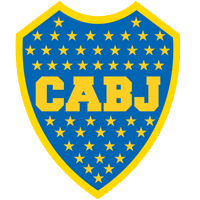 |
|||
| Full name | Club Atlético Boca Juniors | ||
|---|---|---|---|
| Nickname(s) | Los Xeneizes (The Genoese) La Mitad Más Uno (Half Plus One) La Azul y Oro (The Blue and Gold) Los Bosteros (The Manure Handlers) El Rey de Copas (The King of Trophies) |
||
| Founded | April 3, 1905 | ||
| Ground | Estadio Alberto J. Armando (La Bombonera), La Boca, Buenos Aires (Capacity: 49,000) |
||
| Chairman | |||
| Manager | |||
| League | Argentine Primera División | ||
| Clausura 2010 | 16th | ||
| Website | Club home page | ||
| All-time top scorer | Martín Palermo: 222 goals | ||
|
|||
Club Atlético Boca Juniors, known simply as Boca Juniors or Boca, is a popular Argentine sports club, best known for its football team. Its home base is the neighborhood of La Boca, in Buenos Aires, and their home field is Estadio Alberto J. Armando, better known as La Bombonera. Their main rival is River Plate, with whom they contest the Superclásico.
The club have combined to win 41 official tournaments. They had won a record 18 international titles,[1] equal to A.C. Milan. Their haul includes six Copa Libertadores[2], four Recopa Sudamericana, three world club titles (Intercontinental Cup)[3], two Copa Sudamericana, one Copa Oro, one Supercopa Sudamericana, and one Supercopa Masters. Boca Juniors is one of eight teams to have won CONMEBOL's treble (the others being Olimpia, São Paulo, Independiente, Vélez Sársfield, Cruzeiro, Internacional and LDU Quito). Domestically, the club has won 23 national championships, second only to River Plate (33).
The club is usually a permanent fixture in the IFFHS Club World Ranking top 25 and has reached the top position of the monthly ranking 6 times (mostly during coach Carlos Bianchi's tenure).[4] Boca is currently ranked 290th.[5]
The youth academy has produced many Argentine internationals such as Juan Román Riquelme, Nicolás Burdisso, Carlos Tévez and Fernando Gago who have played or are playing for top European clubs.
Contents |
History
Foundation

On April 3, 1905, five Italian immigrants gathered in the Plaza Solís, located in the heart of the La Boca neighborhood of Buenos Aires.[6] Esteban Baglietto, Alfredo Scarpati, Santiago Sana, and brothers Juan and Teodoro Farenga founded Boca Juniors. Other important founders include Arturo Penney, Marcelino Vergara, Luis Cerezo, Adolfo Taggio, Giovanelli, Donato Abbatángelo, Bertolini.[7] The use of English language in football team names was commonplace, as British railway workers had originally introduced association football into Argentina.[8]
Boca Juniors played in local leagues and the amateur second division until being promoted to the first division in 1913, when the division was expanded from six teams to 15.[9] Boca were never relegated; they won six amateur championships (1919, 1920, 1923, 1924, 1926, and 1930).[10] With the introduction of professional football in Argentina, Boca won the first title in 1931.[11]
- First Match: April 21, 1905. vs. Mariano Moreno.
- First international match: December 8, 1907. vs. Universal (Montevideo, Uruguay)
- First professional match: May 31, 1931 vs. Chacarita Juniors.
Kit and badge
The original jersey colour was pink, but this was quickly abandoned for thin black-and-white vertical stripes.[12] Legend has it that in 1906, Boca played another team that used this strip to decide who would get to keep it. Boca lost, and decided to adopt the colors of the flag of the first boat to sail into the port at La Boca. This proved to be the 4146 ton freighter "Drottning Sophia", a Swedish vessel sailing from Copenhagen.[13] As a result, the yellow and blue of the Swedish flag were adopted as the new team colours.[14] The first version had a yellow diagonal band, which was later changed to a horizontal stripe.[15]
Kit evolution and rare kits
- First kit evolution
|
1905
|
1905
|
1905–06
|
1907–13
|
1913–present
|
- Rare models and special editions
|
1998 Copa Mercosur
|
2000–01 Copa Mercosur
|
2005 100th anniv.*
|
2006–07 away kit
|
2007–08 away kit
|
2010 105th. anniv.**
|
*: This model was worn just for 2 matches during 2005 Torneo de Verano (Summer Tournament) in order to commemorate the 100th anniversary of the institution.
**: This model was worn just for 2 matches versus River Plate in 2010 Torneo de Verano
Kit manufacturer and Shirt sponsors
| Period | Kit Manufacturer | Shirt Sponsors |
|---|---|---|
| 1980–1982 | Adidas | None |
| 1983 | Vinos Maravilla | |
| 1984 | Dekalb | |
| 1985 | None | |
| 1986–1988 | Fate | |
| 1989–1992 | FIAT | |
| 1992–1993 | Olan | Parmalat |
| 1994–1995 | ||
| 1995–1996 | Olan / Topper | Quilmes |
| 1996–2001 | Nike | |
| 2001–2003 | Pepsi | |
| 2003–2004 | Pepsi & Goodyear | |
| 2004–2005 | Red Megatone & Goodyear | |
| 2006 | Megatone & Goodyear | |
| 2007–2009 | Megatone & Unicef | |
| 2009–Current | LG & Total |
Jerseys
A list of all the original jerseys is available at the club's official website.
 |
 |
 |
 |
 |
 |
 |
 |
 |
 |
 |
 |
 |
 |
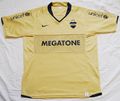 |
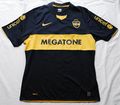 |
Badge
The club has had five different designs for its crest during its history, although its outline has remained unchanged throughout its history. In 1955, laurel leaves were added to celebrate the club's 50th anniversary, and the colours were changed to match those on the team's jersey.[16] In 1970, one star was added to the badge for each title won[17] domestically (at the top, above the initials) and internationally (at the bottom). A new star was added to the corresponding section whenever Boca wins a title. To the delight of fans, the crest had to be modified several times in recent years. In 2007, the club changed its crest to include only 3 stars, one for each Intercontinental Cup / Club world title .
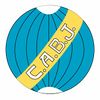
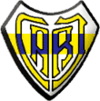


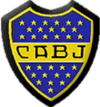
Stadium
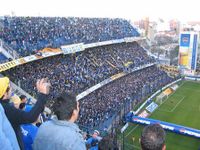
Boca Juniors used several locations before settling on their current ground on Brandsen. Their first ground was in la Dársena Sur but it was vacated in 1907 as it failed to meet the minimum league requirements. They then used three grounds in the Isla Demarchi area between 1908 and 1912.[18] Between 1914 and 1915, the club moved away from La Boca for the only time in its history, moving to Wilde in the Avellaneda Partido of the Buenos Aires Province but a relatively poor season[19] and poor attendances in 1915 forced them to move back to La Boca.
On 25 May 1916, Boca opened their new stadium at the intersection of Calle Ministro Brin and Calle Senguel, playing there until 1924 when they moved to their current location on Calle Brandsen and Calle Del Crucero.
Construction work on the concrete structure of their current stadium started in 1938 under the supervision of Engineer José L.Delpini. Boca played their home matches in the Ferrocarril Oeste ground in Caballito until it was completed in 1940.[18] A third level was added in 1953, giving the ground its nickname La Bombonera ('The Chocolate Box').[20] The stand opposite the Casa Amarilla railway platforms remained mostly undeveloped until 1996, when it was upgraded with new balconies and VIP boxes. Three sides of the Bombonera are made up of traditional sloping stadium stands, but the fourth side had to be built vertically, with several seating areas stacked one on top of the other, to stay within the stadium's property. La Bombonera is renowned for vibrating when fans start to jump in rhythm; in particular, the unique vertical side will sway slightly, leading to the phrase, "the Bombonera does not tremble. It beats." (La Bombonera no tiembla. Late.)
The Bombonera currently has a capacity of around 61,000. The club's popularity make tickets hard to come by, especially for the Superclasico game against River Plate.[21] There are further improvements planned for the stadium, including measures to ease crowd congestion, use of new technology and improved corporate facilities.[22]
- Dársena Sud: 1908 - 1912
- Wilde: 1914 - 1915
- Brins y Sengüel: 1916 - 1924
- Brandsen: from 1924
Supporters
.jpg)
Boca Juniors is traditionally regarded as the club of Argentina's working class, in contrast with the supposedly more upper-class base of cross-town arch rival Club Atlético River Plate.[23]
Boca Juniors claims to be the club of "half plus one" (la mitad más uno) of Argentina's population, but a 2006 survey placed its following at 40%,[24] still the largest share. They have the highest number of fans, as judged by percentage in their country.
The Boca-River Superclásico rivalry is one of the most thrilling derbies in the world.[25] Out of their 327 previous meetings, Boca have won 121, River 105 and there have been 101 draws.[26] After each match (except draws), street signs cover Buenos Aires at fans' own expense, "ribbing" the losing side with humorous posters. This has become part of Buenos Aires culture ever since a Boca winning streak in the 1990s.
In 1975, a film (La Raulito) was made about the life of Mary Esher Duffau, known as La Raulito, a well-known Boca Juniors fan. She died at the age of 74 on 30 April 2008, the same day Boca Juniors played a Copa Libertadores match against Brazilian club, Cruzeiro Esporte Clube with the players and fans observing a minute's silence in her memory.[27]
Nicknames
Boca fans are known as los xeneizes (the Genoese) after the Genoese immigrants who founded the team and lived in La Boca in the early 20th century.[28]
Many rival fans in Argentina refer to the Boca Juniors' fans as Los Bosteros (the manure handlers), originating from the horse manure used in the brick factory which occupied the ground where La Bombonera stands. Originally an insult used by rivals, Boca fans are now proud of it.[29]
Reflecting the team's colors, Boca's shirt is also called la azul y oro (the blue and gold).[30]
There is also a society which dedicates all of its activities to supporting the team known as la número 12 or la doce (player number doce or 12, meaning "the 12th player")[31]
International
Peñas (fan clubs) exist in a number of Argentine cities and abroad in countries such as Russia, Ukraine,[32] Spain,[33] Israel[34] and Japan.[35]
Boca Juniors are particularly popular in Japan because of the club's success in recent years at the Intercontinental Cup held in Japan. All over the world, fans are drawn to Boca by the club's international titles, and by the success of Boca players who went on to play in European football such as Hugo Ibarra, Rodolfo Arruabarrena, Diego Cagna, Enzo Ferrero, Roberto Abbondanzieri, Nicolás Burdisso, Fernando Gago, Diego Maradona, Claudio Caniggia, Gabriel Batistuta, Juan Román Riquelme and Carlos Tévez.
Boca have fans throughout Latin America and also in parts of the United States where there has been Latin immigration and where in July 2007, after the club had toured pre-season, it was reported that the club were considering the possibility of creating a Boca Juniors USA team to compete in Major League Soccer (MLS) with New York City, Miami, Los Angeles and Arizona mentioned as possible locations.[36]
Rivalries
Boca Juniors has had a long standing rivalry with River Plate. The Superclásico is known worldwide as one of world football's fiercest and most important rivalries.[37] It is particularly noted for the passion of the fans, the stands of both teams feature fireworks, coloured confetti, flags and rolls of paper. Both sets of supporters sing passionate songs (often based on popular Argentine rock band tunes) against their rivals, and the stadiums are known to bounce with the simultaneous jumping of the fans. Sometimes the games have been known to end in riots between the hardest supporters of both sides or against the police. The English newspaper The Observer put the Superclásico at the top of their list of 50 sporting things you must do before you die.[38]
The two clubs both have origins in the poor riverside area of Buenos Aires known as La Boca. River however moved to the more affluent district of Núñez in the north of the city in 1923. Boca Juniors and River Plate have played 327 games all time against each other, with Boca winning 121, River 105 and 101 times the games ended in a draw. In the Professional Era the two clubs have played 184 games with Boca winning 68, River 61 and 55 draws.[39]
This intense rivalry has not stopped players from playing for both clubs, most notably Gabriel Batistuta and Claudio Caniggia.
Players
Current squad
Current squad for Boca Juniors as of December 7, 2010 ()
Sources: Argentine Soccer
|
|
Caretaker: Roberto Pompei
Top scorers
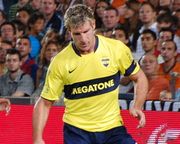
 Martín Palermo (1997~2001; 2004~present) 222 goals*
Martín Palermo (1997~2001; 2004~present) 222 goals* Roberto Cherro (1926~1938) 221 goals
Roberto Cherro (1926~1938) 221 goals Francisco Varallo (1931~1939) 194 goals
Francisco Varallo (1931~1939) 194 goals Domingo Tarasconi (1922~1932) 193 goals
Domingo Tarasconi (1922~1932) 193 goals Jaime Sarlanga (1940~1948) 128 goals
Jaime Sarlanga (1940~1948) 128 goals Mario Boyé (1941~1949; 1955) 124 goals
Mario Boyé (1941~1949; 1955) 124 goals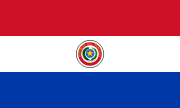 Delfín Benítez Cáceres (1932~1938) 115 goals
Delfín Benítez Cáceres (1932~1938) 115 goals
- * Still active as of May 3, 2010.
Notable players
- To appear in this section a player must have played at least 50 games for the club
- Amateur Era (1905–31)
 Pedro Calomino (1911~13, 1915~24)
Pedro Calomino (1911~13, 1915~24) Américo Tesoriere (GK) (1916~27)
Américo Tesoriere (GK) (1916~27) Alfredo Garasini (1916~28)
Alfredo Garasini (1916~28) Ramón Muttis (1923~32)
Ramón Muttis (1923~32) Ludovico Bidoglio (1922~31)
Ludovico Bidoglio (1922~31) Domingo Tarasconi (1922~32)
Domingo Tarasconi (1922~32) Roberto Cherro (1926~35)
Roberto Cherro (1926~35) Antonio Alberino (1929~34)
Antonio Alberino (1929~34)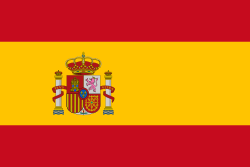
 Pedro Arico Suárez (1929~42)
Pedro Arico Suárez (1929~42)
- Professional Era (1931–present)
-
- 1930s - 1970s
|
|
|
-
- 1970s - 1990s
|
|
|
-
- 1990s - 2000s
|
|
|
Coaches
Boca's two most successful coaches were Juan Carlos Lorenzo (1976~79, 1987), and Carlos Bianchi, (1998–2002, 2003~04). Toto Lorenzo won five titles with the team, including the Libertadores Cup in 1977 and 1978, the Intercontinental Cup in 1977, and the Metropolitano and Nacional in 1976. Bianchi won nine, including Aperturas in 1998, 2000 and 2003, the 1999 Clausura, the Libertadores Cup in 2000, 2001, and 2003, and the Intercontinental Cup in 2000 and 2003.
On 22 August 2006, it was announced that Ricardo Lavolpe would take over the post of coach on September 15, replacing Alfio Basile, who had been selected to manage Argentina National Football Team. Lavolpe failed to continue Basile's chain of success, losing the 2006 Apertura championship in spite of a 4 points advantage with only two rounds to go.
Miguel Angel Russo was hired as Lavolpe's replacement. Boca took second place to San Lorenzo de Almagro in the 2007 Clausura tournament, but went on to win the Copa Libertadores with a 5-0 overall rout of Brazilian Grêmio.
Carlos Ischia was hired after Miguel Angel Russo left to go be San Lorenzo de Almagro's Coach.
Institutional
Executive Board 2008-2011[40]
- President: Jorge Amor Ameal
- 2nd Vice-president: José Beraldi
- 3rd Vice-president: Juan Carlos Crespi
- Secretary: Oscar A. Vicente
Chairmen
Pedro Pompilio was the club's last elected chairman, succeeding Ing. Mauricio Macri (current Head of Government of the Autonomous City of Buenos Aires). Pompilio died during his presidency on October 30, 2008 due to heart attack. His family asked not to send flowers to his funeral and donate money to UNICEF instead. He was 58 years old at that time.[41] He was married and had two children.[42]
Jorge Amor Ameal, 1st vice president during Pedro Pompilio's direction, is the new Boca Juniors president.[43] Boca's most successful president was Mauricio Macri (1996–2008). During his era, the club has won most of its international titles.
Honors
Boca Juniors is one of the most successful teams in Argentine football. They have won six amateur title in Argentina's amateur era. In the professional era, they have won 23 league titles, second only to River Plate. In South American and international club football, Boca has won 18 titles, a world record they share with A.C. Milan.
National
- Primera División
- Winner (23): 1931, 1934, 1935, 1940, 1943, 1944, 1954, 1962, 1964, 1965, 1969 Nacional, 1970 Nacional, 1976 Metropolitano, 1976 Nacional, 1981 Metropolitano, Apertura 1992, Apertura 1998, Clausura 1999, Apertura 2000, Apertura 2003, Apertura 2005, Clausura 2006, Apertura 2008
- Runner-up (18): 1933, 1945, 1946, 1947, 1950, 1958, 1973 Metropolitano, 1978 Metropolitano, 1988-1989, 1990-1991, 1991-1992, 1997 Apertura, Apertura 2002, Clausura 2003, Clausura 2004, Apertura 2006, Clausura 2007, Clausura 2008
International
- Copa Libertadores
- Champion (6): 1977, 1978, 2000, 2001, 2003, 2007
- Runner-up (3): 1963, 1979, 2004
- Copa Sudamericana
- Winner (2): 2004, 2005
- Recopa Sudamericana
- Winner (4): 1990, 2005, 2006, 2008
- Runner-up (1): 2004
- Supercopa Sudamericana
- Winner (1): 1989
- Runner-up (1): 1994
- Intercontinental Cup/ FIFA Club World Cup
- Winner (3): 1977,[44] 2000, 2003
- Runner-up (2): 2001, 2007
- Supercopa Masters
- Winner (1): 1992
- Copa de Oro
- Winner (1): 1993
- Interamerican Cup
- Runner-up (1): 1977
Amateur competitions
- Copa Río de La Plata
- Runner-up (3): 1919, 1920, 1940
- Amateur Era
- Winner (6): AAF 1919, AAF 1920, AAF 1923, AAF 1924, AAF 1926, 1930
- Runner-up (3): 1927, 1928, 1929
Records
- Boca Juniors and Milan both hold a world record 18 official international titles.
- Boca Juniors has the most official titles (domestic and international) for an Argentine football club with 41 titles in the professional era (48 including amateur titles).
- Boca Juniors were awarded the title "Campeón de Honor" (Honour Champion) in 1925, due to a highly successful tour through Europe in which the club played Real Madrid, Atlético Madrid and Real Sociedad, as well as German and French teams, with an impressive record of 15 wins, one draw and three defeats. This title was declared official by the Argentine Football Association, thereby increasing the total number of amateur and professional titles to 49 (31 domestic and 18 international titles).
- 40 consecutive Primera División matches unbeaten - an Argentine record: from 5 May 1998 to 2 June 1999, with 29 victories and 11 draws.[45]
- Three times winner of the Intercontinental Cup (now replaced by FIFA Club World Cup), a record tied with Peñarol, Nacional, Milan and Real Madrid.
Products and services
Boca Juniors has expanded its activity beyond sport, providing its fans with a number of other products and services.
In 2003, it became the fifth football club in the world to open its own TV channel. Boca TV broadcasts 24 hours a day, featuring sports programs and talk shows.
There is a line of Boca coffins available for dead fans,[46] as well as an official Boca Juniors cemetery.[47]
Boca has its own fleet of taxis operating in Buenos Aires.[48]
The club also sells its own brand of wine, called Boca Wine.[49]
Other sports
Basketball
The Boca Juniors basketball team has won the Argentine league three times (1996/97, 2003/04, 2006/07), five Argentine Cups (Copa Argentina 2002, 2003, 2004, 2005, 2006), the Argentine Top 4 (2004), and three South American Club Championships (2004, 2005, 2006).[50][51] It also reached the 2004–2005 national finals (losing to Ben Hur). Their home arena is the Luis Conde Arena, better known as La Bombonerita (small Bombonera).
Team Roster 2009–2010
- As of January 11, 2010.[52]
| Number | Name | Position | Date of birth | Height | Nationality |
|---|---|---|---|---|---|
| 4 | Mariano Fierro | F | 1986 | 200 cm | |
| 6 | Gabriel Mikulas | F | 1980 | 201 cm | |
| 7 | Cedric Moodie | G | 1978 | 187 cm | |
| 8 | Nicolás Aguirre | G | 1988 | 182 cm | |
| 9 | Juan Martín Orellano | G | 1989 | 192 cm | |
| 12 | Nelson Ingles | G | 1975 | 181 cm | |
| 13 | Rodrigo Sánchez (Team captain) | F | 1989 | 200 cm | |
| 16 | Leandro Podestá | C | 1989 | 206 cm | |
| 22 | Sebastián Castiñeira | F | 1978 | 196 cm | |
| 32 | Brian Woodward | G | 1981 | 192 cm | |
| 44 | Fernando Martina | F/C | 1981 | 202 cm | |
| 45 | Derrick Alston | C/F | 1972 | 210 cm |
Manager: Pablo D´Angelo
Volleyball
Boca Juniors has a professional volleyball team that won the Metropolitan championship in 1991, 1992 and 1996, and achieved the second place in the 1996/97 A1 season. Because of a lack of sponsors, the team was disbanded, but later it was reincorporated through the coaching of former Boca player Marcelo Gigante; after playing in the second division, it returned to the A1 league in 2005.
Women's football
The Boca Juniors women's football team plays in the Campeonato de Fútbol Femenino and have won the championship a record 17 times of which 10 were in succession from the 2003 Apertura to the 2008 Clausura.[53]
- Campeonato de Fútbol Femenino
- Winner (17): 1992, 1998, 1999, 2000 (unbeaten), 2001 Apertura, 2002 Clausura, 2003 Apertura, 2004 Clausura, 2004 Apertura, 2005 Clausura, 2005 Apertura, 2006 Clausura, 2006 Apertura, 2007 Clausura, 2007 Apertura, 2008 Clausura and 2009 Apertura.
Other
Starting 2005, the Argentine Turismo Carretera stock-car competition league spun off the Top Race V6 category, in which teams are sponsored by football teams. Veteran race pilots Ortelli and Bessone and former Boca player Vicente Pernía drive for the Boca team; Ortelli finally won the first Top Race V6 championship for Boca Juniors.
In Futsal, Boca has won 4 Championships: 1991, 1992, Clausura 1997, and Apertura 1998.
Boca representatives also compete in other disciplines such as judo, karate, taekwondo, wrestling, weight lifting and gymnastics.[54]
References
- ↑ CONMEBOL Article
- ↑ RSSSF Copa Libertadores
- ↑ RSSSF Copa Intercontinental
- ↑ IFFHS Club World rankings statistics
- ↑ IFFHS Club World rankings current standings
- ↑ BBC Sport article
- ↑ "Historia de Boca Juniors". Informexeneize.com. http://www.informexeneize.com.ar/historia_1.htm. Retrieved 8 June 2010.
- ↑ "Boca Juniors club history". Boca Juniors.com. http://www.bocajuniors.com.ar/en-us/the-club. Retrieved 8 June 2010.
- ↑ RSSSF Argentine divisional movements
- ↑ RSSSF Argentine divisional movements
- ↑ RSSSF List of Argentine champions and runners up
- ↑ Solodeportes centenery edition of the shirt
- ↑ Flags of the World article
- ↑ Guardian Article
- ↑ Boca Juniors official website: kits
- ↑ Boca Juniors official website: crests
- ↑ Boca Verense site
- ↑ 18.0 18.1 La Pasion Boca-Boca and their stadiums (Spanish)
- ↑ RSSSF Argentina 1915
- ↑ Midfield Dynamo stadium profiles
- ↑ Independent article
- ↑ Boca Juniors official website
- ↑ Tim Vickery Column BBC Football
- ↑ "Se cae un mito: la hinchada de Boca no suma la mitad más uno del país" - InfoBae (Spanish)
- ↑ World derbies: Boca Juniors v River Plate - BBC news.
- ↑ ESPN Deportes statistics
- ↑ "Adiós, "Raulito"" (in Spanish). infobae.com. 2008-05-01. http://www.infobae.com/notas/nota.php?Idx=377770&IdxSeccion=0. Retrieved 2008-05-27.
- ↑ Flags of the World article. The word xeneize is Genoese dialect for the Ligurian word zeneize, which means "Genoese".
- ↑ Taringa: see comment by senomar1234 23.06.2007 18:44:25
- ↑ Clarín Article (Spanish)
- ↑ canaltrans.com article (Spanish)
- ↑ Russian-Ukrainian fan-site Narod.ru (Russian)
- ↑ Bocajuniors.com.ar: Listado de Peñas(Spanish)
- ↑ Labaton, Dana; Szerman, Luli (March, 2003). "Club Atlético Boca Juniors - Los bosteros de la rivera" (in Spanish). Piedra Libre. http://www.piedralibre.co.il/revista/2003/03/2003_03_equipo_boca.asp. Retrieved 2008-06-21.
- ↑ "Cómo viajó "La 12" a Japón y logró ingresar al estadio olímpico de Tokio" (in Spanish). MDZ Online. 2007-12-12. http://www.mdzol.com/mdz/nota/21635/. Retrieved 2008-06-21.
- ↑ "Boca Juniors Considers Starting an MLS Expansion Team". theoffside.com. 2007-07-31. http://www.theoffside.com/south-america/boca-juniors-mulls-starting-an-mls-expansion-team.html. Retrieved 2008-06-21.
- ↑ BBC Academy, famous football derbies
- ↑ 50 sporting things you must do before you die
- ↑ Superclásico - TyC Sports(Spanish)
- ↑ Boca Juniors official website:Executive Board
- ↑ "Falleció Pedro Pompilio"
- ↑ "Murió el presidente de Boca, Pedro Pompilio, de una afección cardíaca"
- ↑ "Ameal, the new president"
- ↑ Actually played on 1978
- ↑ "Boca Juniors' series of 40 matches unbeaten in the Primera División" - RSSSF
- ↑ "Boca soccer fans' grave devotion" - BBC news
- ↑ "Loyalty to Boca Juniors now truly cradle to grave" - International Herald Tribune
- ↑ "Boca taxis sure to be shunned by River fans" - tiscali.news
- ↑ "Boca fans - in life & death" - TheWorldGame
- ↑ "Liga Nacional de Básquet - Boca Juniors" (in spanish). LNB.com.ar. http://www.lnb.com.ar/liga/bocajuniors.php. Retrieved 2009-09-17.
- ↑ "El Básquetbol de Boca Juniors" (in spanish). Bocajuniors.com.ar. http://www.bocajuniors.com.ar/deportes/basquet/historia-en-la-liga-nacional. Retrieved 2009-09-17.
- ↑ "Plantel de Básquet" (in Spanish). Boca Juniors official website. January 2010. http://www.bocajuniors.com.ar/deportes/basquet/ficha/. Retrieved 11 January 2010.
- ↑ "SUPLE GOLAZO!". Diario El Heraldo. http://elheraldo.com.ar/ver_noticias.php?id_nota=38128. Retrieved 1 August 2010.
- ↑ "Deportes". Boca Juniors official website. http://www.bocajuniors.com.ar/deportes/amateurs. Retrieved 1 August 2010.
External links
- Official website
- Boca Juniors results and Statistics at RSSSF
- History of Boca Juniors (Spanish)
- Player biographies (Spanish)
|
|||||||||||||||||||||||||||||
|
|||||||||||||||||